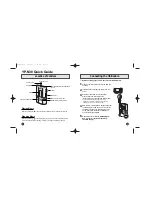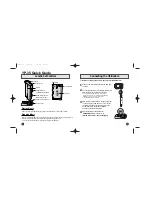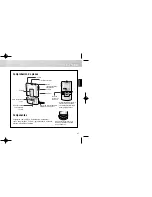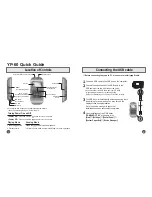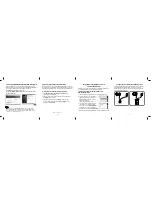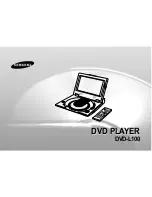
92
DVD VIDEO (page 8)
A disc that contains up to 8 hours of moving
pictures even though its diameter is the same
as a CD.
The data capacity of a single-layer and single-
sided DVD is 4.7 GB (Giga Byte), which is 7
times that of a CD. The data capacity of a
double-layer and single-sided DVD is 8.5
GB, a single-layer and double-sided DVD is
9.4 GB, and double-layer and double-sided
DVD is 17 GB.
The picture data uses the MPEG 2 format, a
worldwide standard of digital compression
technology. The picture data is compressed to
about 1/40 (average) of its original size. The
DVD also uses a variable rate coding
technology that changes the data to be
allocated according to the status of the
picture. Audio information is recorded in a
multi-channel format, such as Dolby Digital,
allowing you to enjoy a more realistic audio
presence.
Furthermore, various advanced functions
such as the multi-angle, multilingual, and
Parental Control functions are provided with
the DVD.
DVD-RW (page 8)
A DVD-RW is a recordable and rewritable
disc that is the same size as a DVD VIDEO.
The DVD-RW has two different modes: VR
mode and Video mode. DVD-RWs created in
Video mode have the same format as a DVD
VIDEO, while discs created in VR (Video
Recording) mode allow the contents to be
programmed or edited.
DVD+RW (page 8)
A DVD+RW (plus RW) is a recordable and
rewritable disc. DVD+RWs use a recording
format that is comparable to the DVD VIDEO
format.
A JPEG image recorded on a DATA CD
(“File” is an exclusive definition for this
player.) A single file consist of a single
image.
Film based software, Video based
software (page 22)
DVDs can be classified as Film based or
Video based software. Film based DVDs
contain the same images (24 frames per
second) that are shown at movie theaters.
Video based DVDs, such as television
dramas or sit-coms, displays images at 30
frames/60 fields (24 frames/50 fields) per
second.
HDMI (High-Definition Multimedia
Interface)
HDMI is an interface that supports both video
and audio on a single digital connection. The
HDMI connection carries standard to high
definition video signals and multi-channel
audio signals to AV components such as
HDMI equipped TVs, in digital form without
degradation.
Since the video signals are compatible with
the current DVI (Digital Visual Interface)
format, HDMI jacks can be connected to DVI
jacks by way of an HDMI-DVI converter
cord. The HDMI specification supports
HDCP (High-bandwidth Digital Contents
Protection), a copy protection technology that
incorporates coding technology for digital
video signals.
Normal (Interlace) format (page 22)
Normal (Interlace) format shows every other
line of an image as a single “field” and is the
standard method for displaying images on
television. The even number field shows the
even numbered lines of an image, and the odd
numbered field shows the odd numbered lines
of an image.
Progressive format (page 22)
Compared to the Interlace format that
alternately shows every other line of an image
(field) to create one frame, the Progressive
format shows the entire image at once as a
single frame. This means that while the
Interlace format can show 25 or 30 frames
(50-60 fields) in one second, the Progressive
format can show 50-60 frames in one second.
The overall picture quality increases and still
images, text, and horizontal lines appear
sharper. This player is compatible with the
480 (525) progressive format.


























